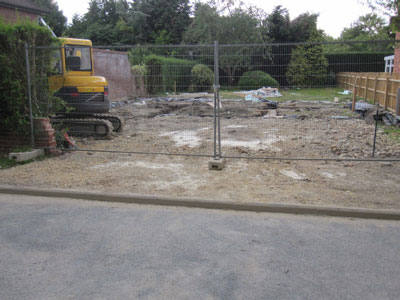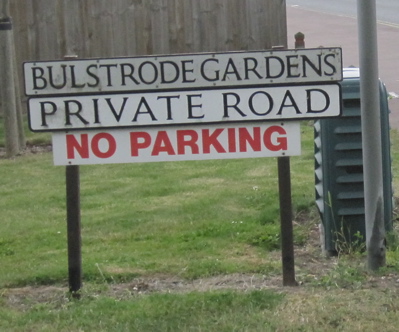
At Cambridge City Council’s West/Central Area Committee on the 18th of June 2009 city councillors from Castle, Market and Newnham wards decided on a planning application for a new house to be built in the garden of 14 Bulstrode Gardens. Permission to build a house on this plot had already been given by the West/Central Area Committee in September 2008. Councillors then agreed with a point put forward by Cllr Smith – that the only reason this plot was empty was that someone had bought up two plots when the development was built and unanimously (though Dixon, Kightley and Reid were absent) gave permission for the building to go ahead.
The applicant submitted amended plan and as the changes were significant enough to require permission be sought again the matter was once again taken before the committee. The changes were:
- The removal of the integral garage and the conversion of this space to a kitchen and utility room;
- Reduction of the dwelling by 500mm in width to improve access along the north boundary;
- The addition of a dormer window on the rear elevation;
- The addition of a porch;
- The addition of 3 rooflights to the rear elevation of the property and an additional window at first floor level;
- The omission of 2 rooflights to the front elevation of the property.
Errors and Omissions
Reginald Prescott, who lives next door to the proposed development was a public speaker. He made clear he had no problem with building a house on the plot. What he was concerned about though was how far the new house was to project beyond the back of the existing building line. He drew attention to an error in the previous report with respect to how far back the new house will extend, and questioned if the current plans corresponded with what was already being built at the site. He said he had come to make public his discontent at the fact his objection to that element of the September 2008 application had been dismissed by councillors on the basis of incorrect information.
The council’s planning officer admitted there had been an error in the officer’s report to the previous meeting; which had said the projection to the rear was less than the plans submitted by the applicant showed. The report to September’s meeting had said the new building would extend 1.8m beyond the existing line, but the correct figure scaled from the plans was 2.4m. Mr Prescott claimed what was being built, and what was on the current plans was in fact 3m further back.
Councillors noted the fact that work had already begun on the site, and wondered if the conditions which had to be met before development commenced had in fact been met. The planning officer was unable to answer this question, saying he was unaware of any issues and had no reason to believe the current development was not in line with the planning permission granted in September. Councilors asked that the case be passed to enforcement officers, for them to check, as a matter of urgency:
- How far towards the rear of the site the currently built foundations extend, and if they are in line with the submitted plans
- That the conditions imposed have been complied with
Cllr Rosenstiel questioned how much weight ought to be given to the applicant’s plans, given the fact the name of the street was spelt wrong on them.
Cllr Hipkin asked the planning officer if he was ashamed that such errors and omissions had been made. He also noted that the footprint of the house as a whole had been reduced compared to that for the already approved plans.
Cllr Dixon, looking at the plans noted there were conservatories and extensions on the existing properties. He confirmed that the measurement being discussed was the distance the main two story element of the new house would be further back than the main two story element of the existing houses.
Availability of Plans
Cllr Kightley complained to the planning officer that no plans were included in the papers. The officer said he had posted the plans on the wall of the room half an hour before the meeting; none of the councillors had noticed this. It appeared that none of the councillors making the planning decision had seen the plans until they were passed around by the officer. This is one of the problems of having area committees making planing decisions; where as members of the central planning committee regularly visit the planning office to review plans, members of the area committees often do not, and make decisions either not having viewed plans, or having seen them for a few moments at the committee. I have previously called for some plans to be included in the papers for meetings published online. Cllr Nimmo-Smith has called for artists-impressions to be included to give councillors a better idea of what is to be built, I also think that they ought be included. It is worth noting that those who do visit the planning department to view plans are not permitted to take copies of plans, this results in those opposing applications sometimes relying on hand drawn sketches, or tracings (which those viewing plans are allowed to make) when discussing their opposition. I have discussed this previously in relation to the proposed demolition of 13 Chesterton Road, in that case I broke the council’s rules, in the public interest. I do not think the council ought go beyond warning people of the existence of copyright law, there is no-need for them to ban the taking of copies of plans for legitimate personal or journalistic use.
Parking
Cllr Rosenstiel wondered if in some way the presence of a garage in the initial plans, which was not present in plans under consideration, was a cynical attempt to manipulate the system. Cllr Hipkin suggested that any integral garages ought be considered mindful of the fact they may one-day become a habitable room in any case.

Cllr Rosenstiel questioned the parking provision, noting that the city council’s standards say that a maximum of two parking spaces ought be provided for a new home of this size. He was told that, contrary to the officer’s report (which says there is only one), there are in fact still two parking spaces in-front of the property (another error if the officer presenting at the meeting is to be believed). Cllr Rosenstiel then asked if that meant that the September 2008 application ought have been refused on the basis that it provided three spaces, two plus a garage. The planning officer said yes, but advised it would have been difficult to refuse a planning application on such grounds. This stance raises questions about the value of having such a policy in the first place. Presumably this exchange can be taken as evidence that such policies exist just so the Liberal Democrats can show they’re trying to pursue the aims some of their number have to promote the “dream Cambridge lifestyle of living close to work and cycling around” for an elite while making life for many families, businesses and others less practical. Setting such a policy on one hand, then ignoring it when it comes to making planning decisions is just the kind of fence-sitting indecisiveness that I imagine anyone voting positively for the Liberal Democrats would actively be choosing; in which case democracy appears to be working in Cambridge. Then again perhaps the Lib Dem vote is largely a protest vote against the other parties.
To me the whole discussion appeared to raise the question of: “What’s a parking space?”. When is a parking space a drive, or a turning area? My view is that restricting parking to one or two spaces for a building with potential to become a family home is excessive regulation and not the best way to encourage the use of alternative forms of transport. It is contrary to the concept of making homes suitable for people at all stages of their lives. If those building the house, or later living in it think it will be more practical for them to have an additional parking space then they should, and will, be able to add one. It would be a farce if those building homes in the city were to submit plans for just one parking space, with an intent to built more later. When councils get to the point of interfering unnecessarily with the way people enjoy their own property then they need to stop, and get on with what they are supposed to be doing.
Cycle parking was briefly discussed, with the officer saying there was plenty of space for this on the site. An amendment sheet detailing cycling parking provision is referred to in the report, though was not circulated to the public at the meeting. Councillors did not formally add the provision of any cycle parking as a condition when they approved the planning permission.